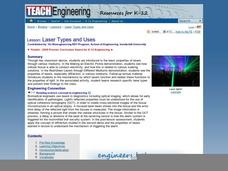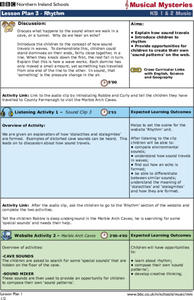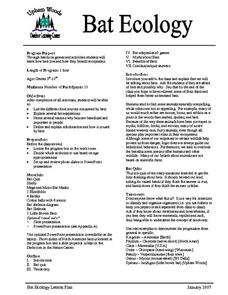Massachusetts Institute of Technology
Nuclear Synthesis
Start this lesson with a bang! The eighth in a 13-part series of lessons explains the origin of elements beginning with the Big Bang Theory. The reading describes the formation of elements hydrogen through uranium.
Curated OER
Internet Dictionary Search-Hearing
In this hearing worksheet, students use a given internet site to find the definition and the part of speech for 9 terms related to hearing and sound.
Curated OER
Speed of Sound
Young scholars investigate the concept of velocity and apply it to the velocity of sound and measure the velocity of sound by measuring the echoes produced in a tube. They show their calculation of time and speed, and then conclude that...
Penguin Books
An Educator's Guide to Matched by Ally Condie
Even supposed Utopian societies have their flaws. Using an educator's guide, individuals explore the society Ally Condie creates in Matched. Reflective writing prompts double as discussion questions and cover key themes in the novel, as...
Curated OER
How Do Bats Navigate At Night?
Through an experiment, learners explore how bats use echolocation. First, they discuss how sound travels through air waves. Then, they talk about the ways bats navigate in the dark. As an extension, they can write about what they have...
Curated OER
Laser Types and Uses
Students examine the properties of lasers and research their types and uses. In this laser lesson students view several demonstrations.
Curated OER
Is a bat a bird?
Provide a concise description of why a bat is not a bird by comparing their traits. This presentation defines both birds and flying mammals, explaining how they are similar and how they are different. Note: This PowerPoint is great for...
Curated OER
Fish Anatomy
Add a handy reference sheet about fish anatomy and functioning to your learners' biology or animal notebooks. Though this resource doesn't provide any practice, it makes a useful addition to any study of anatomy, biology, species, fish,...
Curated OER
Tree-mendous Game
Young scholars play a game where they classify the different characteristics of trees. In this tress lesson plan, students also use tree vocabulary and describe benefits of trees.
Curated OER
Advanced Critical Reading: Biomimetics
Instruct your class on biomimetics while practicing reading comprehension with this activity. Learners read a passage that describes the efforts of scientists, starting with Leonardo da Vinci, to emulate nature to solve issues in...
Curated OER
Whale Echolocation
Students demonstrate how a whale uses echolocation to track food and identify one other animal that also uses echolocation. In this echolocation lesson plan, students play a game where one child (the whale) is blindfolded and gives a...
Curated OER
Musical Mysteries
Students examine the changes that occur to sound as the pressure changes. Echoes and sound changes in caves and tunnels are explored in this activity.
Curated OER
The Adventure of Echo the Bat
Students compare different habitats based on satellite imagery. They identify land features in the satellite imagery.
Curated OER
How Does Sound Behave?
In this sound worksheet, students will brainstorm the cause and effect of sound and how sound behaves in different situations. Students will complete a graphic organizer.
K12 Reader
They See with Their Ears
Sometimes bats get a bad rap, even though they are fascinating creatures! Teach your class about echolocation with a reading passage. After reading, class members respond to five questions based on the text.
Teach Engineering
Catching the Perfect SAR Waves!
Zero in on an interesting resource involving radar technology. Groups construct a radar sensing unit and learn to calibrate the system. Using the radar system and the Pythagorean Theorem, they calculate distances between objects.
Curated OER
Warming the Earth
First graders investigate how the sun warms the Earth and examine the rotation of the Earth and the sun. They create an illustration of the sun, examine a solar system model, and listen to the book "The Sun: Our Nearest Star." They also...
Curated OER
Texture - Bumpy, Wrinkled, Smooth?
Students study textures and identify textures using satellite images. For this texture lesson, students study various objects and define their textures. Students feel crayon rubbings and sort them into groups. Students use a book with...
Curated OER
Seafloor Spreading
In this seafloor spreading worksheet, students find mistakes in statements that are descriptive of seafloor spreading. Students correct the given sentences to make a true statement.
Curated OER
What Are We Looking At?
Learners investigate different perspectives through a farming simulation. In this photo perspectives lesson plan, students examine different photographs taken by satellite or from ground level. Learners then discuss the differences and...
Curated OER
Tornadoes
Students examine the characteristics of a tornado. They practice using new vocabulary and participate in a question and answer session. They use the internet to gather more specific information.
Curated OER
Bat Ecology
Students, through hands on games and activities, discover how bats live and how bats benefit ecosystems. They play a game designed to show them how echolocation works and another to show how mother bats locate their young through their...
Curated OER
Patterns in Nature
Students examine places in nature where patterns can be observed by looking through a number of books after watching a teacher PowerPoint presentation. They illustrate a pattern in nature.
Curated OER
The Physics of Sound: How We Produce Sounds
First graders construct a KWL chart on sound. In this physics lesson plan, 1st graders describe different ways to produce sound. They explain how sound waves propagate.























